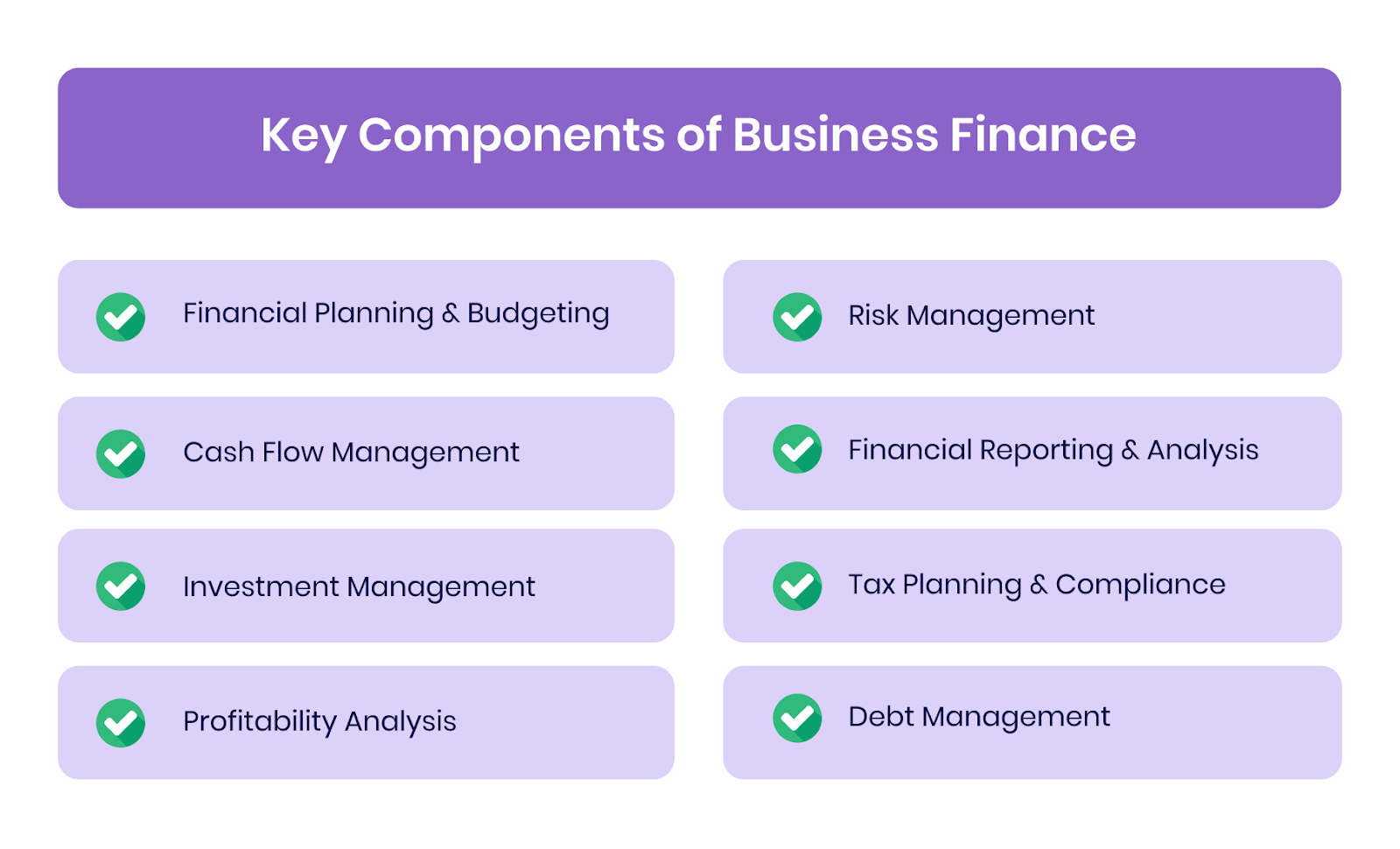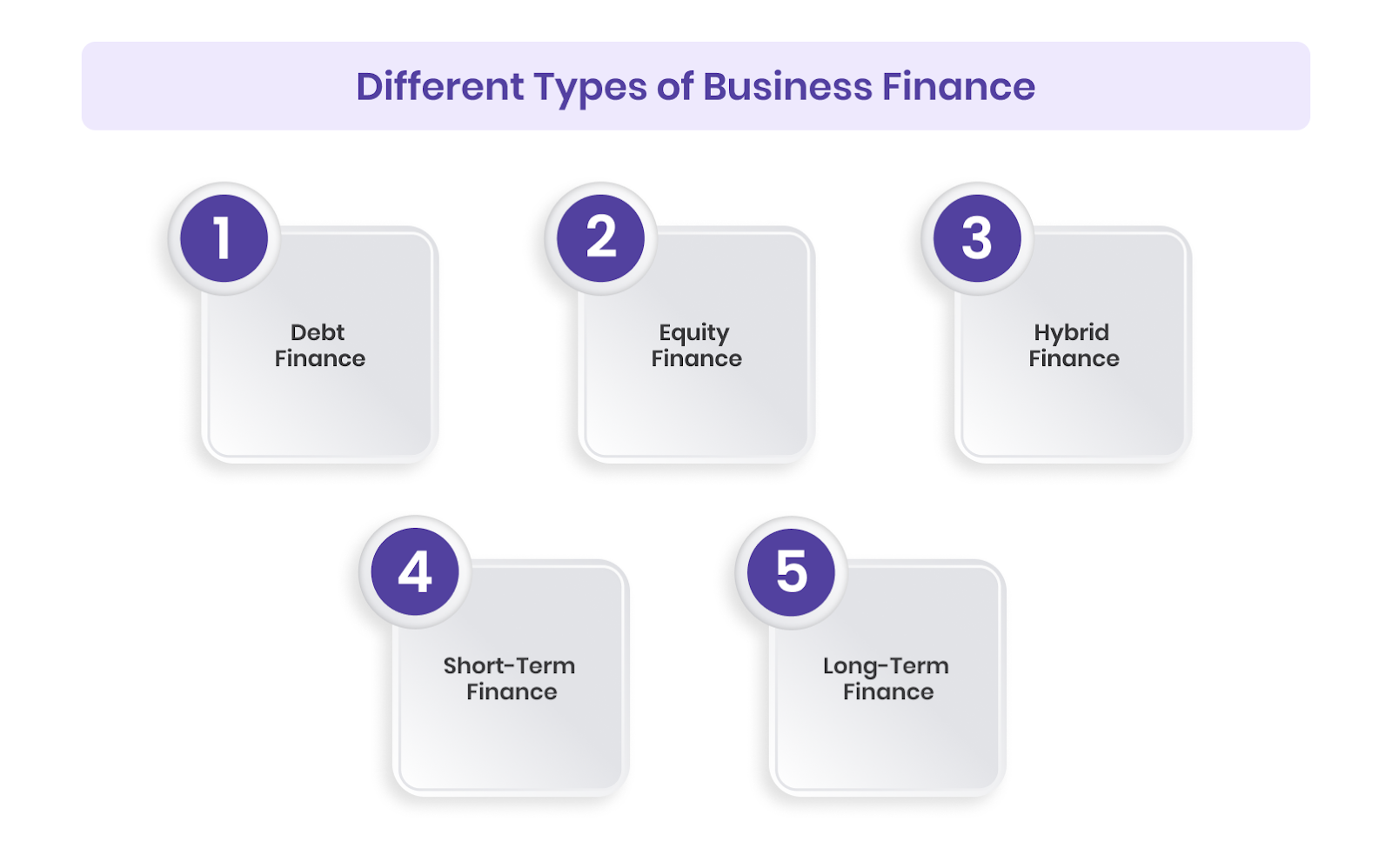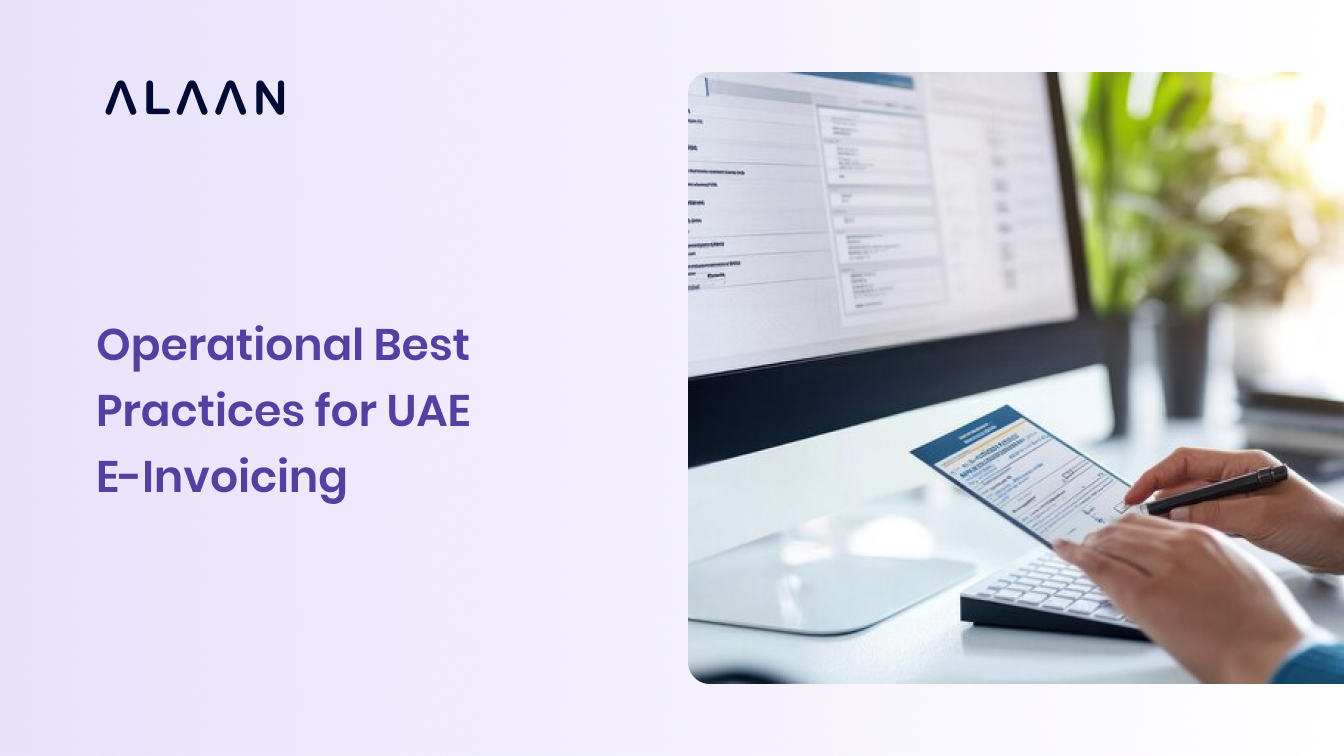UAE businesses are under increasing pressure to optimise cash flow, control expenses, and stay VAT-compliant, especially with e-invoicing becoming mandatory in 2026. Companies that adopt digital financial tools early are expected to cut invoice processing costs by more than 60%, gaining a clear competitive advantage.
For finance managers, the focus has shifted. It’s about using smart financial planning and technology to drive growth, reduce risks, and stay compliant.
This guide takes a close look at the key levers of business finance in the UAE, covering funding strategies, risk management, VAT automation, and fintech adoption. You’ll find practical insights you can apply right away to strengthen your financial operations.
Key Takeaways
- Financial Planning and Budgeting – Establishing clear goals, forecasting revenues, and allocating resources effectively ensures businesses operate efficiently and monitor spending.
- Cash Flow and Investment Management – Monitoring cash flow and making strategic investments helps maintain liquidity, support growth, and avoid financial strain.
- VAT Compliance and Tax Planning – Understanding UAE VAT laws, registering appropriately, filing returns, and planning taxes carefully protects profitability and avoids penalties.
- Technology in Finance – Automation, real-time reporting, AI-based forecasting, and integrated fintech solutions streamline processes, improve accuracy, and enhance decision-making.
- Funding and Business Finance Types – Accessing the right mix of internal/external finance, debt, equity, or hybrid options supports operational needs, expansion, and sustainable growth.
Key Components of Business Finance

Understanding the core components of business finance is crucial for any company that wants to manage its money wisely and achieve sustainable growth. These components help businesses monitor performance, make better decisions, and use resources more effectively. Below are the key components of business finance.
1. Financial Planning and Budgeting
Financial planning is about setting clear goals, forecasting revenues, and mapping out the best way to achieve them. It acts as a roadmap for how resources should be allocated over a set period, whether monthly, quarterly, or annually.
Budgeting goes hand in hand with planning. It creates a detailed breakdown of expected income and expenses, helping businesses allocate resources wisely and monitor spending.
2. Cash Flow Management
Cash flow management focuses on tracking the money coming in and going out of the business. This ensures the company has enough liquidity to handle everyday operations without disruption.
By monitoring cash flow closely, companies can meet obligations such as paying employees, suppliers, and creditors on time. Strong cash flow management also prepares businesses for lean periods and helps avoid sudden financial strain.
3. Investment Management
Investment management is about using capital in the most effective way to grow the business. This may include buying assets, upgrading equipment, or adopting new technology to boost productivity and efficiency.
Businesses must weigh opportunities carefully when entering a new market, launching products, or securing long-term assets to ensure resources are directed toward profitable ventures.
4. Profitability Analysis
Profitability analysis helps determine whether a company is generating enough income compared to its expenses. It involves looking at key metrics like gross, operating, and net profit margins to understand overall financial health.
Regularly reviewing profitability allows businesses to adjust strategies, cut unnecessary costs, and refine pricing models to strengthen margins.
5. Risk Management
Risk management is about identifying and addressing financial risks before they become serious problems. These risks may include shifts in market conditions, currency fluctuations, credit defaults, or supply chain issues.
By anticipating risks and building strong strategies, companies can protect themselves from financial shocks and remain resilient.
6. Financial Reporting and Analysis
Financial reporting involves preparing key documents such as balance sheets, income statements, and cash flow statements. These reports provide a clear picture of the company’s financial position and help stakeholders, like investors, lenders, and management, make confident decisions.
Financial analysis goes a step further by using these reports to identify trends, measure performance, and highlight areas for improvement.
7. Tax Planning and Compliance
Tax planning focuses on minimising liabilities while staying fully compliant with tax laws. This includes utilising available deductions, credits, and strategies to manage obligations effectively.
Staying compliant with FTA regulations avoids penalties and ensures smooth and lawful business operations.
8. Debt Management
Debt management deals with handling loans and credit responsibly to ensure that obligations are met without straining cash flow. It involves deciding when to borrow, how much, and setting a clear repayment strategy.
For businesses in the UAE, where financing is often sought through banks or investors, managing debt wisely is crucial. Done right, debt can fuel growth; done poorly, it can lead to over-leveraging and financial stress.
After identifying the key components, the next step is to look at where businesses can access the funds they need to operate and expand.
Sources of Business Finance
Every business needs funds to manage its daily operations, expand, or plan for long-term growth. These funds can come from different sources, such as:
Internal Sources of Finance
Internal finance refers to money generated within the business, without turning to outside lenders or investors. This works best for businesses that already have steady cash flow or reserves. It includes:
- Retained Earnings: Instead of distributing all profits to shareholders, companies often reinvest a portion back into the business. This is one of the most reliable internal funding options for businesses with stable earnings.
- Owner’s Equity: The personal investment made by the owner or founders. For startups and small businesses in the UAE, this is usually the first and most important source of funding.
- Sale of Assets: Businesses can raise money by selling non-essential or underutilised assets such as machinery, property, or old inventory. This helps free up capital for new projects or to pay off debts.
- Cash Flow: Strong cash flow management ensures that earnings from operations are enough to cover day-to-day expenses. Maintaining a positive cash flow is crucial for meeting short-term needs without relying on external financing.
External Sources of Finance
External finance involves raising money from outside the business. This is often necessary when larger amounts are required, or when internal reserves aren’t sufficient. It includes:
- Bank Loans: One of the most common options, bank loans provide funds that are repaid with interest over a set period. In the UAE, businesses with a good financial track record can use loans for working capital or expansion.
- Lines of Credit: A flexible arrangement that lets businesses borrow up to a certain limit whenever needed. It’s especially useful for handling short-term cash flow gaps or unexpected expenses.
- Venture Capital: Startups and high-growth businesses in sectors like technology, fintech, or e-commerce often seek venture capital. Investors provide funds in exchange for equity, usually backing companies with strong potential.
- Angel Investors: Wealthy individuals who invest in early-stage businesses in return for equity or convertible debt. In the UAE, angel investors are a valuable source of seed funding for startups.
- Crowdfunding: Through platforms like Kickstarter or Indiegogo, businesses can raise small contributions from a large number of people. This approach is popular in the UAE, especially for product launches and community-driven projects.
- Government Grants and Subsidies: The UAE government actively supports businesses in key sectors such as technology, renewable energy, and manufacturing. Grants and subsidies provide funding that typically does not need repayment, which reduces the financial burden on businesses.
With funding options in mind, it’s useful to understand the different types of finance available and how each can support business goals.
Different Types of Business Finance

Understanding the different types of business finance is important for companies when deciding how to raise funds for operations, growth, or expansion. Each option has its own benefits and works best for different business situations. Below are the different types of business finance.
1. Debt Finance
Debt finance means borrowing money that must be repaid with interest. It’s a common way for businesses to access funds without giving up ownership. This includes:
- Bank Loans: Businesses borrow money from banks and repay it over an agreed period with interest. In the UAE, loans are often used for expansion or major purchases.
- Bonds and Debentures: Larger companies may issue bonds or debentures to raise money from investors, promising repayment with interest. This is usually for long-term projects.
- Trade Credit: Suppliers may allow businesses to receive goods or services now and pay later. It’s a short-term option that helps with cash flow.
- Lines of Credit: A flexible arrangement where businesses can draw funds up to a limit when needed. It’s useful for emergencies or managing liquidity gaps.
2. Equity Finance
Equity finance involves raising capital by offering ownership shares in the business. Unlike debt, it doesn’t need to be repaid, but it does dilute ownership. This includes:
- Shares/Stock Issuance: Larger businesses can issue shares to raise substantial funds, often through the UAE’s public equity markets.
- Venture Capital: Venture capitalists invest in high-growth companies, especially in tech, fintech, and e-commerce, in exchange for equity.
- Angel Investors: Wealthy individuals who provide early-stage funding, often in return for equity or convertible debt. Angel investors are a strong part of the UAE’s startup ecosystem.
3. Hybrid Finance
Hybrid finance combines elements of both debt and equity, offering flexibility and balance. This includes:
- Convertible Debt: A loan that can later be converted into equity, giving businesses time before ownership dilution.
- Mezzanine Financing: A mix of debt and equity, often used for expansion. If the business defaults, the debt may convert into equity.
4. Short-Term Finance
Short-term finance helps businesses cover immediate expenses, working capital needs, or unexpected costs. This includes:
- Overdrafts: Enable businesses to withdraw more money than what’s available in their account, providing quick access to cash.
- Invoice Financing (Factoring): Businesses sell unpaid invoices to a third party at a discount to get immediate cash. In the UAE, this helps bridge the gap between billing and receiving payments.
- Trade Credit: Businesses can delay payments to suppliers, easing short-term cash flow pressures.
5. Long-Term Finance
Long-term finance is used to fund major investments, large projects, or expansion plans. This includes:
- Long-Term Loans: Loans with repayment terms of 5 to 10 years, commonly used for buying property, machinery, or infrastructure.
- Leasing: Allows businesses to use assets like equipment or vehicles without a large upfront cost. Regular payments are made, often with the option to buy the asset later.
- Bonds: Large companies can issue bonds to raise capital for long-term projects, paying interest to bondholders until maturity.
Once you are aware of the types of business finance, it’s helpful to know how technology can simplify financial management and improve decision-making.
Also Read: The future of AI in Finance: How is AI reshaping the financial landscape?
The Role of Technology in Business Finance
Technology has changed the way businesses manage their finances, making processes faster, more accurate, and easier to access. Adopting financial technology is essential for growth, compliance, and efficiency. Here are some of the key ways technology is driving change in modern business finance:
- Automation of Financial Processes: Routine tasks like bookkeeping, invoicing, and expense tracking can now be automated. This reduces human error, speeds up processes, and ensures records are always up to date.
- Real-Time Financial Reporting: Instead of waiting for monthly or quarterly reports, businesses can now access financial data in real time. This enables finance leaders to adjust strategies quickly and make informed decisions.
- Improved Financial Forecasting: AI and machine learning tools can analyse past data to create accurate forecasts. These insights help businesses plan budgets, predict cash flow, and prepare for uncertainties.
- Enhanced Security and Compliance: Modern financial tools offer built-in security features such as encryption, fraud detection, and secure payment gateways. Automated systems can track VAT transactions, generate compliant invoices, and ensure accurate tax reporting.
- Cloud-Based Financial Solutions: Cloud platforms make financial data accessible from anywhere, support secure document storage, and allow easy integration with other business tools.
- Data Analytics and Insights: Advanced analytics tools provide a deeper look into spending patterns, cost drivers, and profitability. By tapping into data-driven insights, UAE businesses can identify opportunities to reduce costs, invest wisely, and improve performance in a constantly evolving market.
- Digital Payments and Cash Flow Management: Digital payment solutions such as Apple Pay, Google Pay, and PayPal have simplified transactions, reduced costs, and improved collection speed.
- Integration with Other Business Systems: Today’s financial tools integrate smoothly with CRM, ERP, HR, and inventory management systems. This improves overall efficiency by allowing smooth data exchange across different departments.
Alongside technology, UAE businesses must go through VAT rules and compliance requirements to stay aligned with regulations.
Understanding VAT and Compliance for UAE Businesses
Value Added Tax (VAT) is a consumption tax applied at each stage of the supply chain, charged on the value added to goods and services. In the UAE, the VAT rate is 5%, which is relatively low compared to many other countries.
However, it still requires businesses to have proper systems in place for tracking, reporting, and remitting tax to the Federal Tax Authority (FTA).
VAT matters for the UAE businesses because it helps create:
- Revenue for the Government: VAT is an important source of income for the UAE government, helping fund public services and infrastructure projects.
- Impact on Businesses: Any business whose taxable supplies and imports exceed AED 375,000 annually must register for VAT. Registration ensures businesses can claim input VAT on expenses and avoid penalties.
- Affect on Pricing and Profitability: Since VAT is added to the selling price of goods and services, it directly affects pricing strategies. Businesses must carefully account for VAT in their pricing models to protect profitability while remaining compliant.
A general understanding of VAT shows the specific requirements businesses need to meet for compliance.
Key Requirements for VAT Compliance
Staying compliant with VAT laws is critical to avoid fines, penalties, and reputational risks. Below are the main areas UAE businesses must manage:
1. VAT Registration
Businesses in the UAE must register for VAT if their taxable supplies exceed a certain threshold. Businesses with taxable supplies above AED 375,000 per year must register; those between AED 187,500 and AED 375,000 may register voluntarily.
Registration is completed through the FTA portal, providing details about the business, its activities, and projected taxable turnover.
2. VAT Invoicing
Businesses should ensure each invoice clearly shows all required details, including the VAT charged. Invoices must show the VAT rate, VAT amount, and the business’s Tax Registration Number (TRN).
Each invoice should include the seller’s TRN, date, goods/services description, total including VAT, and the VAT rate/amount.
3. VAT Reporting and Filing
Regular reporting keeps businesses compliant and helps track VAT obligations accurately. VAT returns need to be filed monthly or quarterly, depending on turnover, showing output VAT (on sales) and input VAT (on purchases). Also, returns must be submitted by the 28th of the month following the tax period.
Businesses should reconcile VAT collected versus VAT paid to determine whether they owe the FTA or are due a refund.
4. VAT Payment
Paying VAT on time is crucial to avoid penalties. Businesses must calculate their net VAT due and submit it according to deadlines.
Net VAT (output minus input) must be paid by the filing deadline, as late payments attract penalties and interest. If input VAT exceeds output VAT, businesses can claim a refund from the FTA.
5. Record-Keeping
Keeping accurate VAT records is key for audits and compliance. Businesses must retain VAT-related documents (invoices, receipts, contracts, etc.) for at least five years. Using accounting software with VAT tracking features helps simplify record-keeping and reporting.
6. Audits and VAT Inspections
The FTA can conduct audits to verify that businesses are meeting VAT obligations. Audits can include checking filings, invoices, and operations to ensure compliance.
Non-compliance can result in fines, such as late filing, which leads to AED 1,000 for the first offence and AED 2,000 for repeat offences. Also, 4% annual interest on outstanding amounts is charged as late payments.
Meeting compliance standards also involves being aware of common financial mistakes and finding ways to prevent them.
Common Financial Mistakes and Ways to Avoid Them
Financial missteps can seriously affect a business’s growth and long-term sustainability in the UAE. Mistakes in managing cash flow, investments, or compliance can result in missed opportunities and operational challenges. Below are some of the most common financial errors UAE businesses make, along with practical ways to avoid them:
How Alaan Optimises Business Finance Management in the UAE?
In the UAE, efficient financial management is essential for long-term success. At Alaan, we provide a comprehensive business finance platform designed to simplify VAT management, optimise workflows, and ensure full compliance with UAE regulations. Here's what Alaan offers:
- End-to-End Financial Control: Gain complete visibility over all financial activities, from VAT compliance to cash flow management, within a single platform. This enables businesses to stay on top of obligations and make informed decisions in real-time.
- Smart VAT Management: Automate VAT calculations, generate compliant reports, and track tax obligations with ease. Alaan simplifies VAT workflows, helping businesses comply with UAE regulations while saving time and reducing errors.
- Real-Time Financial Insights: Access actionable insights into your finances for smarter, data-driven decisions. From budgeting to cost optimisation, Alaan helps you manage financial performance smoothly.
- Smooth Accounting Integrations: Integrate your existing accounting software for smooth, real-time synchronisation of financial data. This eliminates manual entry and ensures accuracy across all records.
- Automated Receipt Matching: Link receipts to transactions automatically, reducing administrative work and ensuring precise, audit-ready financial records.
- Instant Payments and Smart Controls: Manage vendor payments with effective spend controls, set budgets, approve expenses, and make contactless payments, keeping financial operations efficient and under control.
Schedule a demo to learn more.
Wrapping Up
Effective business finance forms the backbone of a company’s growth and sustainability, especially when managing VAT and maintaining compliance in the UAE. By following financial practices, from strategic VAT management to optimising cash flow, you can set your business up for success and eliminate costly mistakes.
At Alaan, we recognise the challenges businesses face in handling financial operations. Our platform provides AI-powered tools to simplify VAT compliance, streamline expense tracking, and optimise cash flow.
Book a quick demo today to discover how Alaan can optimise your business finance management, improve cash flow visibility, and effortlessly ensure VAT compliance.
FAQs
1. What is business finance?
Business finance is all about how a company manages its finances, from raising funds to handling expenses and maintaining a financially sound business. It’s about balancing the books and making smart decisions on where and how to use resources so the company can run smoothly, grow steadily, and achieve its long-term goals.
2. Why does business finance matter?
Business finance is crucial because it ensures smooth operations, supports strategic decision-making, drives growth and profitability, and maintains regulatory compliance. It helps manage financial risks, all of which are essential for long-term success in competitive markets like the UAE.
3. How can businesses manage cash flow effectively in the UAE?
Businesses can manage cash flow effectively in the UAE by monitoring inflows and outflows, ensuring timely payments from customers, and managing expenses carefully. Many businesses use digital tools to automate and track cash flow for better control.
4. What are the key financial management practices in the UAE?
Key financial management practices in the UAE include budgeting, financial forecasting, risk management, and VAT compliance. Staying updated on regulations helps avoid penalties and ensures smooth operations.
5. How can businesses in the UAE secure funding?
Businesses in the UAE secure funding by bank loans, equity financing, government grants, or venture capital, depending on the business’s stage, financial health, and growth potential.
6. What are the tax implications for businesses in the UAE?
In the UAE, VAT is applied at 5% on most goods and services. Businesses must file VAT returns regularly and maintain accurate financial records to avoid penalties.
7. How do UAE businesses handle financial reporting?
UAE businesses handle financial reporting by preparing balance sheets, income statements, and cash flow reports. Accurate and timely reporting supports internal decision-making and compliance with regulations.


.avif)







